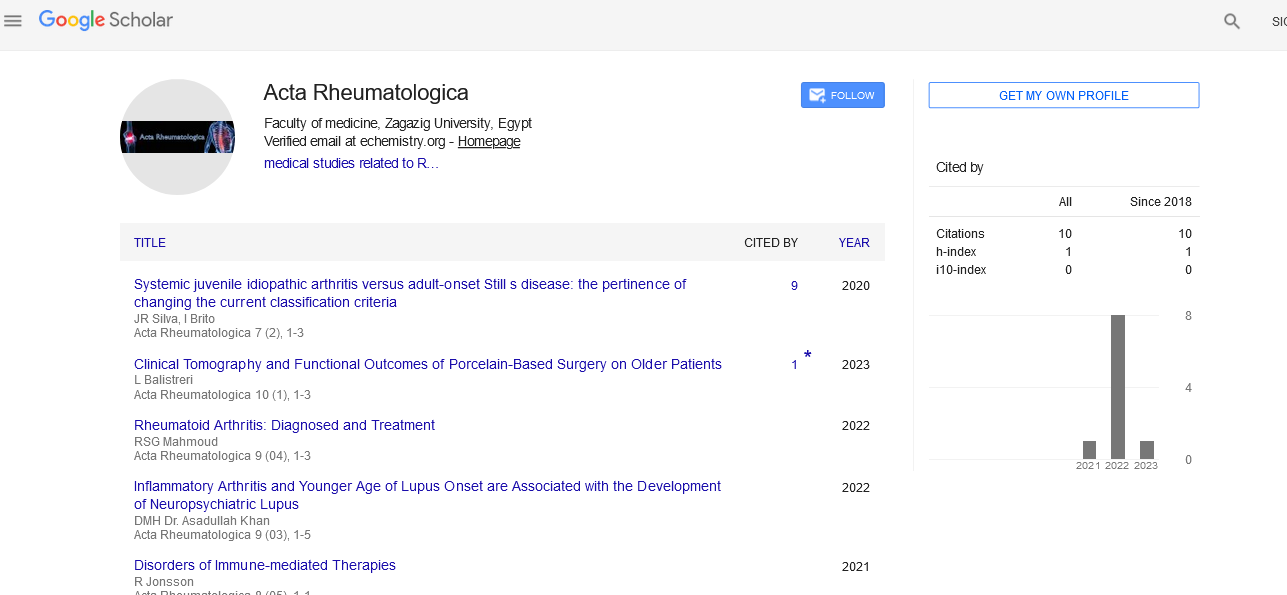Perspective - (2025) Volume 12, Issue 1
Stem Cell Therapy: A Revolutionary Approach to Regenerative Medicine
Zhong Zheng*
Department of Health Care, Loma Linda University, Loma Linda, California, USA
*Correspondence:
Zhong Zheng, Department of Health Care, Loma Linda University, Loma Linda, California,
USA,
Email:
Received: 20-Feb-2025, Manuscript No. IPAR-25-15560;
Editor assigned: 24-Feb-2025, Pre QC No. IPAR-25-15560 (PQ);
Reviewed: 11-Mar-2025, QC No. IPAR-25-15560;
Revised: 19-Mar-2025, Manuscript No. IPAR-25-15560 (R);
Published:
27-Mar-2025
Introduction
Stem cell therapy is a groundbreaking field in regenerative medicine that utilizes stem cells to repair, replace, and regenerate damaged tissues and organs. These unique cells have the potential to develop into various specialized cell types, offering hope for treating numerous diseases and injuries. Over the past few decades, stem cell therapy has gained significant attention due to its potential to revolutionize the treatment of conditions such as neurodegenerative diseases, orthopedic injuries, and even cardiovascular disorders.
Understanding stem cells
Stem cells are undifferentiated cells with the ability to self-renew and differentiate into specialized cell types. They are categorized based on their potential to differentiate:
Totipotent stem cells: Can develop into any cell type, including embryonic and extraembryonic tissues.
Pluripotent stem cells: Can differentiate into almost any cell type in the body but not extraembryonic tissues.
Multipotent stem cells: Can develop into a limited range of cell types within a specific lineage (e.g., blood cells or muscle cells).
Unipotent stem cells: Can only differentiate into one specific cell type.
Types of stem cells used in therapy
Embryonic Stem Cells (ESCs): Derived from early-stage embryos, these cells have high pluripotency but are associated with ethical concerns and immune rejection risks.
Adult Stem Cells (ASCs): Found in various tissues like bone marrow and adipose tissue, these multipotent cells are commonly used in regenerative therapies.
Induced Pluripotent Stem Cells (iPSCs): Reprogrammed adult cells that behave like embryonic stem cells, offering a promising alternative without ethical concerns.
Mesenchymal Stem Cells (MSCs): Found in bone marrow, fat, and umbilical cord tissue, MSCs are widely used in orthopedic, cardiac, and neurological treatments.
Applications of stem cell therapy
Stem cell therapy has been explored for a wide range of medical conditions, including:
Neurological disorders
Parkinson’s disease: Stem cells help regenerate dopamine-producing neurons, alleviating symptoms.
Alzheimer’s disease: Potential to replace damaged brain cells and slow disease progression.
Spinal cord injuries: Promotes nerve regeneration and functional recovery in paralyzed patients.
Orthopedic conditions
Osteoarthritis: MSCs aid in cartilage regeneration and pain relief.
Bone fractures: Enhances healing and reduces the need for surgical interventions.
Tendon and ligament injuries: Accelerates repair and strengthens damaged tissues.
Cardiovascular diseases
Heart failure: Stem cells improve heart function by regenerating damaged myocardial tissue.
Peripheral artery disease: Enhances blood vessel formation, improving circulation in affected limbs.
Autoimmune and in inflammatory diseases
Rheumatoid arthritis: Reduces inflammation and repairs joint damage.
Multiple sclerosis: Modulates immune response and promotes nerve repair.
Diabetes
Type 1 diabetes: Potential to regenerate insulin-producing beta cells in the pancreas.
Type 2 diabetes: Improves glucose metabolism and reduces complications.
Cancer treatment
Hematologic cancers: Bone marrow transplantation using stem cells is a common treatment for leukemia and lymphoma.
Solid tumors: Experimental approaches aim to use stem cells to target and eliminate cancer cells.
Stem cell therapy techniques
Several methods are used to deliver stem cells for therapeutic purposes:
Intravenous infusion: Used for systemic conditions such as autoimmune disorders and neurological diseases.
Direct injection: Stem cells are injected into specific tissues; such as joints for osteoarthritis or the heart for cardiac repair.
Surgical implantation: Involves placing stem cells within scaffolds to facilitate tissue regeneration, commonly used in bone and cartilage repair.
Benefits of stem cell therapy
Regeneration and repair: Stimulates natural healing processes and tissue regrowth.
Minimally invasive: Reduces the need for complex surgeries and long recovery periods.
Reduced dependency on medications: Decreases reliance on painkillers and anti-inflammatory drugs.
Potential for personalized medicine: iPSCs allow for patientspecific treatments, minimizing immune rejection.
Challenges and ethical considerations
Despite its promise, stem cell therapy faces several challenges:
Ethical concerns: Use of embryonic stem cells raises moral and ethical debates.
Tumorigenicity: Risk of uncontrolled cell growth leading to tumors.
Immune rejection: Some stem cells may be rejected by the recipient’s immune system.
High costs: Treatments can be expensive and are not always covered by insurance.
Future of stem cell therapy
The field of stem cell therapy is rapidly evolving, with ongoing research focusing on:
Gene editing and CRISPR technology: Enhancing the safety and efficacy of stem cell treatments.
3D bioprinting: Creating functional tissues and organs for transplantation.
Combination therapies: Integrating stem cell therapy with other regenerative medicine techniques for enhanced outcomes.
Conclusion
Stem cell therapy represents a paradigm shift in modern
medicine, offering hope for treating previously incurable
conditions. With continued advancements in research, ethical
considerations, and technological innovations, the potential of
stem cell therapy will continue to expand, improving lives and
redefining the future of healthcare. While challenges remain,
the promise of regenerative medicine is closer than ever to
transforming patient care on a global scale.





